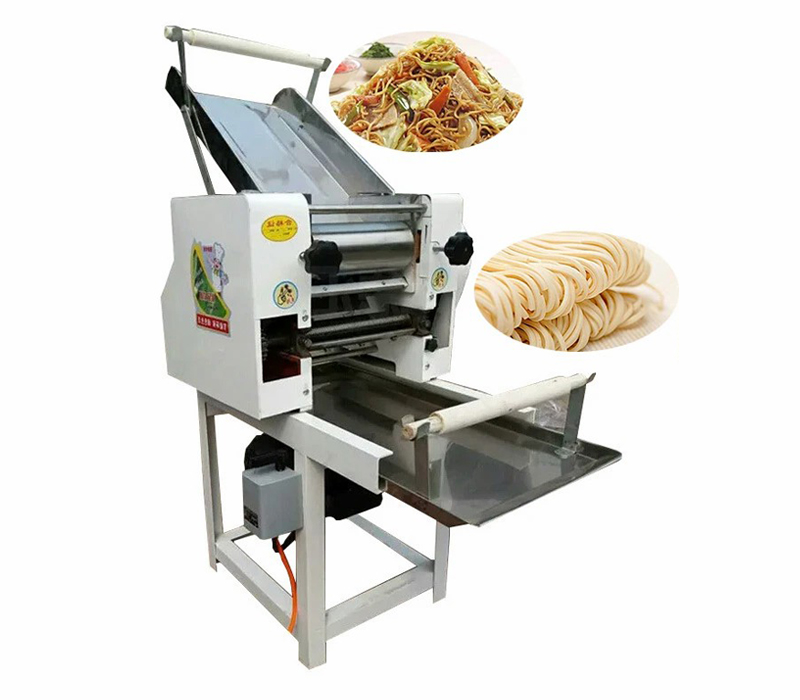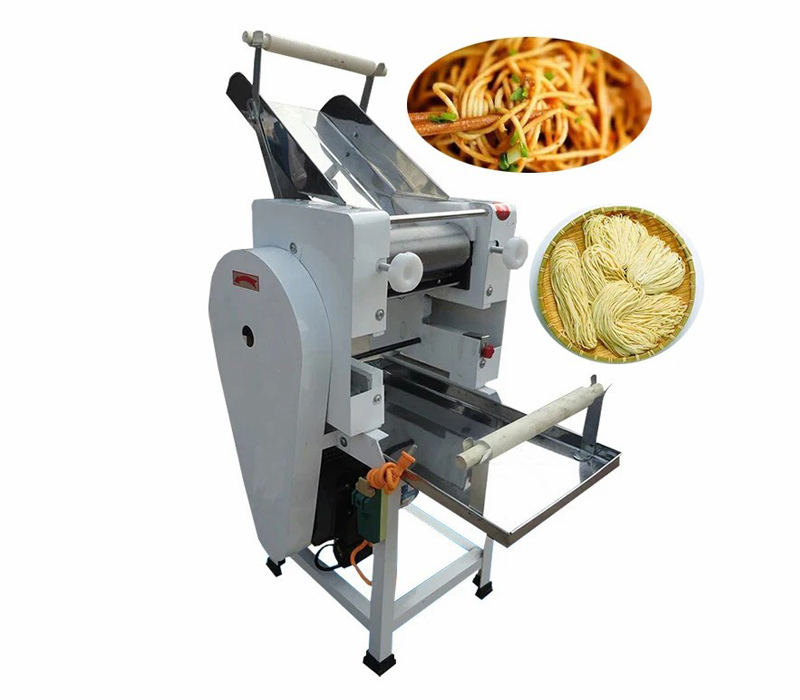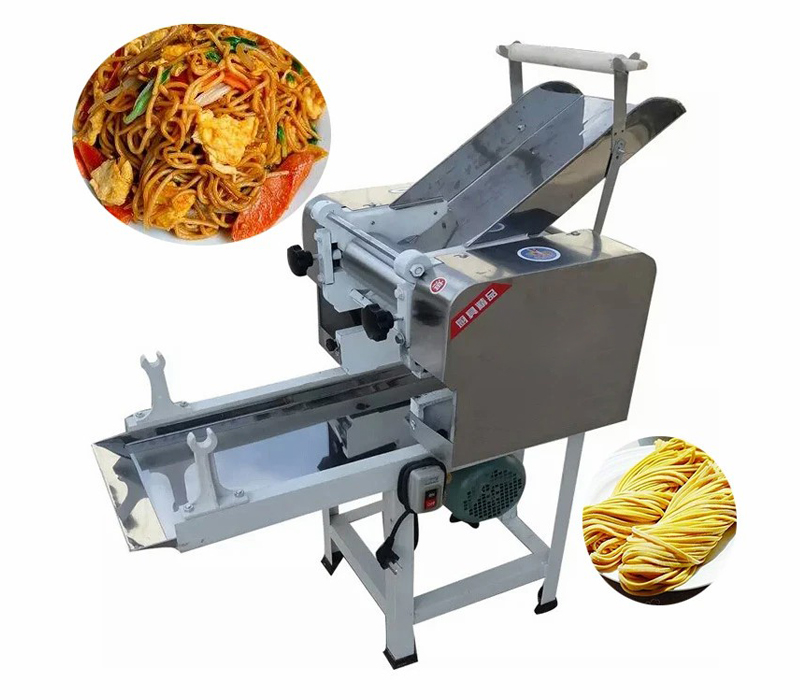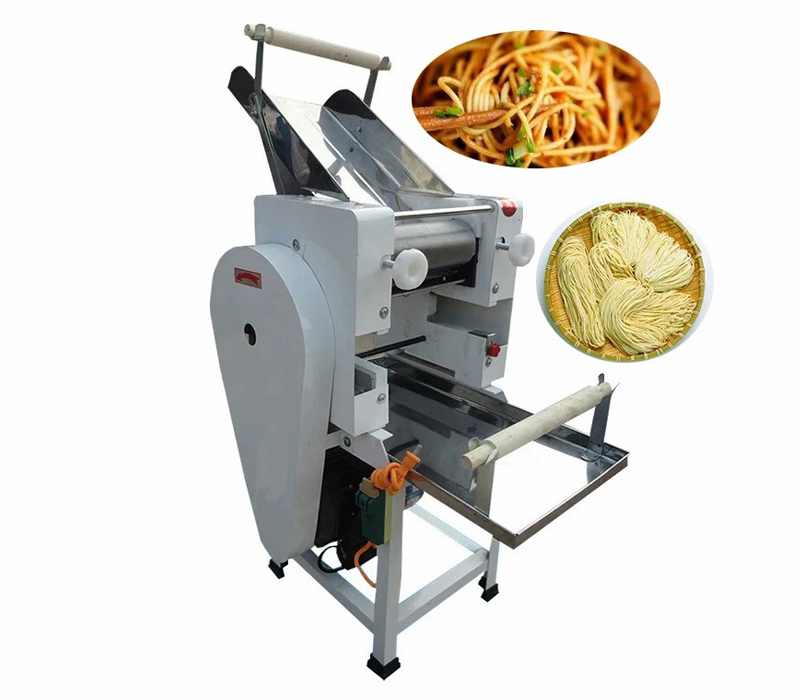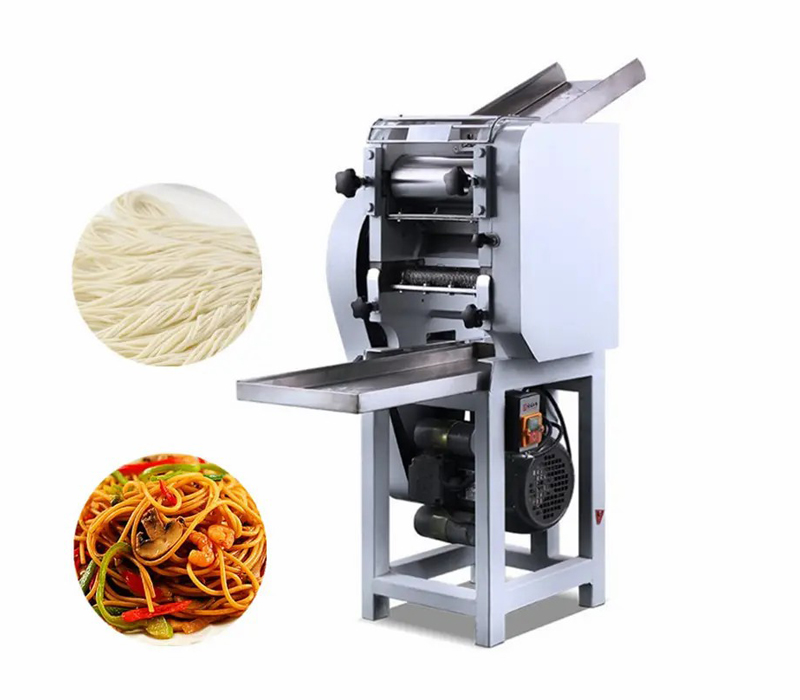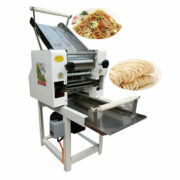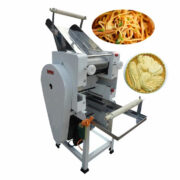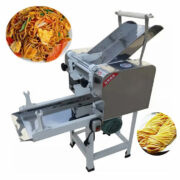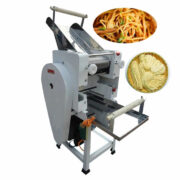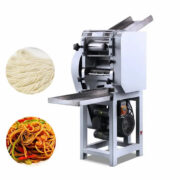Fresh Dry Noodle Machine
Main Benefits
- Fit for many kinds of noodle such as fresh&dry noodle making
- Noodle width can be customized 1.5/2/3/4mm available
- Noodle thickness can be adjustable on roller part
- Fully stainless steel ensure hygienic manufacture
- One-touch waterproof switch, easy operation
- Small investment and floor space required
- Can be operated by single person
- Stable performance, high efficiency
Overview
Introducing our incredible noodle making machine, designed to create unforgettable moments with your loved ones. Whether you’re planning a fun-filled cooking day with your grandkids, a delightful family night activity, or a romantic date night, our noodle making machine is the perfect addition to your kitchen. Crafted with precision and affordability in mind, this mini machine utilizes special heat treatment techniques using food-grade high carbon steel for its dough rollers and blades. This ensures their durability and resistance to rust, while other parts of the machine are treated with anti-corrosion measures such as painting.
The professional gear transmission design incorporates an adjustable gap, resulting in a prolonged service life and exceptional performance. With its versatility, this machine can effortlessly produce noodles, wonton skin, pastry, pasta, and more. Its compact size and impressive gluten toughness make it suitable for a wide range of establishments, including hotels, restaurants, canteens, pastry factories, inkstone and bread mills, as well as individual industrial and commercial use.
Videos
Features
- Smoother Y-shaped falling for improved noodle texture.
- Self-removable noodle making mold for convenience and cleaning.
- Heightened protective copper double scraper for enhanced durability.
- Imported pure copper motor for long-lasting performance.
- Powerful motor with strong power, stable output, and high durability.
- Hand wheel adjustment lever for easy dough thickness adjustment.
- Raised tripod design eliminates bending down and saves effort.
- Humanized design adjustment knob for user-friendly operation.
- Insulating material power switch, waterproof, dirt-proof, and easy to use.
- High-quality noodle knives available in various sizes, customizable.
- Carbon steel dough knife with high-precision processing and durability.
- Continuous appearances without adhesion for consistent results.
- Food-grade stainless steel roller for durability and hygiene.
- Clamp-type adjustment handle for easy dough pressing of different thicknesses.
Specifications
| Model | Capacity (Kg/h) | Power (Kw) | Roller Size(mm) | Dough Thickness Adjustable (mm) | Machine Dimension(mm) |
| NM-40 | 25-40 | 1.5 | 80*220 | 0.6-6 | 520X420X1050 |
| NM-60 | 30-50 | 1.5 | 96*220 | 0.6-6 | 650X540X1080 |
| NM-80 | 60-80 | 2.5 | 102*250 | 0.6-6 | 930x550x1200 |
| NM-125 | 80-120 | 2.5 | 110*260 | 0.6-6 | 650X540X1080 |
FAQ
How to Install a fresh dry noodle machine?
-The machine must be installed on a dry and well-ventilated surface to ensure smooth and reliable operation.
-Before use, verify if the power supply voltage is compatible with the Chinese noodle machine and ensure that the wire core with the grounding symbol is securely grounded.
-Adjust the roller gap from thick to thin when kneading and pressing the dough, with the incoming surface thickness being 2-3 times that of the outgoing surface.
-Install the noodle cutter by placing it into one of the two cutter grooves on the left and right grid plates. Engage the upper gear with the large gear, tighten the nut, and use the fixing bracket to secure the noodle cutter in place.
-Manually insert the end of the dough sheet between the two rolling rolls. After rolling, guide the dough into the dough cutter to cut out the noodles, which will then land on the conveyor belt.
How to operate the fresh dry noodle machine?
-Ensure that the machine is placed on a dry and well-ventilated horizontal surface to ensure smooth and reliable operation.
-Prior to use, check the power supply voltage and install the dough tray and noodle tray according to the provided instructions. (Please note that the trays are not installed on the machine for safety during packaging and transportation).
-Dough sheet pressing: Start the machine and pour in the mixed flour (with a water to flour ratio of 5:1~3:1). Adjust the roller gap to control the thickness of the dough sheet. The incoming dough sheet should be 2~3 times thicker than the outgoing sheet. By repeatedly kneading and pressing the dough sheet, its strength and taste can be improved. Therefore, we recommend users to make full use of the kneading and pressing function of the machine. Before making noodles, the noodle sheet should be approximately 3mm thick. Roll it up using a rod and it will be ready for use.
-Noodle making: Install the noodle blade by inserting it into the slots on the left and right sides of the machine. Secure the noodle blade with the fixed bracket and tighten the nut after ensuring that the gear on the noodle knife aligns with the big gear on the machine.
What precautions should be taken when using the dry fresh noodle machine?
-Ensure that the mixing ratio of noodles and water is 10:3.
-Begin by adjusting the dough roller to the widest position and flatten the dough to approximately 4-5 mm thickness. It can be double-layer pressed from left to right.
-After repeated flattening and smoothing, allow the dough to rest. Adjust the dough roller to about 3 mm and press the dough once.
-Install the top knife and adjust the gap between the top rollers to approximately 2 mm.
-When pressing out the noodles, make sure to sprinkle a small amount of dry flour to prevent the soft noodles from sticking together.
What is the common faults and solutions of noodle making machines?
Button malfunction: If the operating button of the noodle machine is not functioning properly or is unresponsive, you should check for any looseness or debris in the button area. In such cases, it is necessary to clean the affected area and fix the buttons.
Noodles not pulling smoothly: If you experience a stuck feeling while pulling noodles, it might be due to dough or noodles getting stuck inside the machine. To resolve this issue, you can disassemble the machine, clean the area where the noodles are stuck, and apply an appropriate amount of vegetable oil or edible oil to prevent adhesion.
Abnormal sound: If you hear any unusual sounds while using the noodle machine, it is likely that a certain part is damaged or loose. Check if all components are properly installed. If the problem persists, contact the manufacturer for repair.
Sticky noodles: When using a noodle press to make noodles, if you notice that the noodles are too sticky, it could be because the equipment has not been cleaned thoroughly or maintained regularly. It is recommended to clean the equipment regularly and change the oil to ensure cleanliness and optimal working efficiency.
How to troubleshoot if the noodle making machine is not functioning properly?
Check the power supply:
If the pasta maker is not moving, the first step is to check the power supply. Ensure that the power socket is properly connected and try using a different power cord. If the issue persists, use a multimeter to check for any damage or short circuits on the circuit board or wiring.
Unblock the machine:
If the power supply is not the problem, the noodle maker may be blocked. In such cases, disconnect the main body of the machine from the power source, remove the removable parts, and clean them thoroughly. Make sure there are no blockages or damages. Pay special attention to the mold part, as it often gets stuck with residual dough and flour. If there are any parts that cannot be removed, it is recommended to use professional cleaning fluid after disassembling.
Motor issues:
If none of the above steps resolve the issue, there may be a problem with the motor, and it might need to be replaced. Before replacing the motor, manually rotate it a few times to check for any looseness or sticking. If there is severe looseness or jamming, the motor should be replaced.
Summary:
There are multiple solutions for a non-functioning noodle maker, but always remember to unplug the power cord before performing any maintenance tasks for safety purposes. If none of the above troubleshooting methods work, it is recommended to seek professional after-sales service or consider replacing the noodle machine.
What are the special precautions when using a fresh noodle machine?
-Familiarize yourself with the instructions before using the machine and strictly follow them during operation.
-Do not reverse the machine under any circumstances.
-Before starting the machine, carefully inspect all parts for any abnormalities. If any issues are found, address them promptly to prevent accidents.
-Avoid adding iron or other hard objects into the flour to prevent accidents.
-Do not pour the noodles directly into the noodle bucket.
-While the machine is running, never put your hands near dangerous parts such as rollers, gears, chains, or cutters.
-Ensure that all rotating parts, including the oil mark, inside the oil cup, gears, and chain, are properly lubricated.
-To lubricate the machine, add 20#-30# engine oil twice per shift to the oil hole. Additionally, apply a small amount of cooking oil to the cutter surface and roller surface after each shift.
-The clutch of the rolling, cutting, and mixing noodle machine must be in the stopped state.
-Allow the rolling mill to run idly for 10-15 minutes before starting production. In winter, maintain a temperature of at least 10-15 degrees Celsius in the production room.
-Clean the machine thoroughly after shutting it down. Ensure there is no residue or dough left on each roll.
-Keep all gears and rolling bearings properly lubricated.
-Prevent any hard debris from falling into the rollers and gears.
-Replace the bearing grease every six months.
-It is strictly prohibited to adjust the surface roller gap to more than 5 mm during operation.
-The noodle picker is an accessory for the noodle machine. It is used to place the cut and shaped noodles on the upper pole and hang them in the space.

